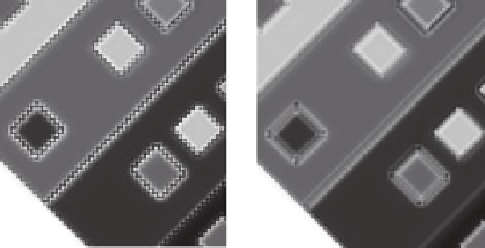Image Processing Reference
In-Depth Information
(a)
(b)
FIGURE 8.7 (See color insert)
Example of comparison of demosaicking: (a) simple processing: shaggy at color border; (b) adaptive processing:
not shaggy at color border.
8.2.4
Color Conversion
Color conversion is signal processing to convert from a color space, which is the signal
of sensor response forms, to another corresponding color space in which the color tone
is natural for perception by the human eye. Processing is carried out using a linear RGB
matrix or color difference matrix. If the sensor signal of the RGB color filter is converted by
the RGB matrix, the scale of the signal processing is small.
Denoting the image signal at pixel
i
after demosaicking, the conversion RGB matrix, and
the image signal at pixel
i
after conversion as (r, g, b)i,
i
,
A
, and (R, G, B)
i
, respectively, we have
the following equation:
R
G
B
r
g
b
=
A
(8.1)
i
i
a
a
a
11
12
13
A
=
a
a
a
(8.2)
21
22
23
a
a
a
31
32
33
The spectral responses of the color filter and matrix
A
are decided in a fine balance of
color reproducibility with SNR, color resolution, processing load, and so on, as shown in
Figure 8.8. While overlapping of each color of the filter is necessary for hue reproducibility,
excess overlap increases off-diagonal elements of matrix
A
to subtract overlap component
and thus tends to reduce SNR.
So far, the operation has been implemented in linear processing.
8.2.5
Color and Tone Matching
The image signal is converted to a standard color space suitable for human perception. In
practice, it is most commonly converted to a color space named sRGB, which is a global

